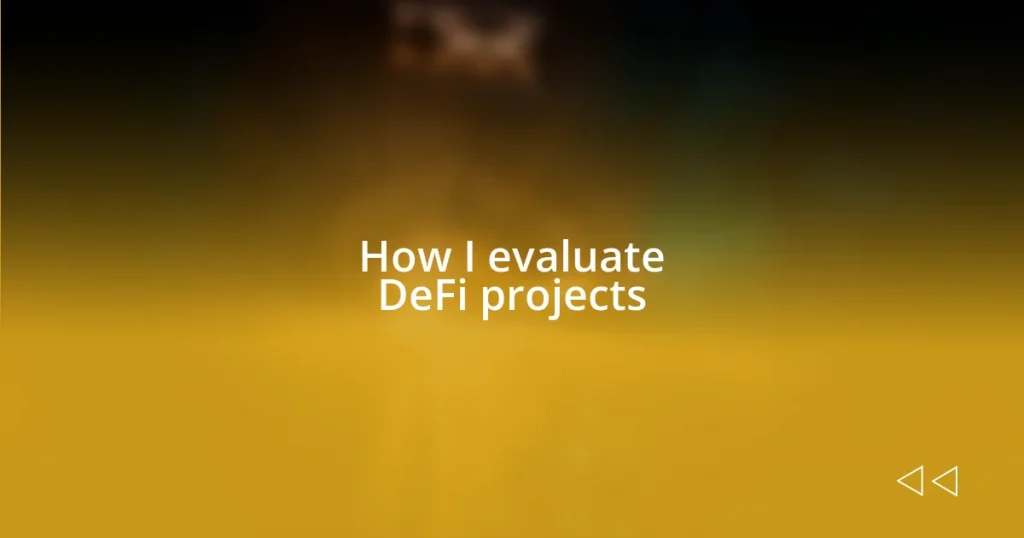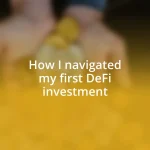Key takeaways:
- Evaluation of DeFi projects should focus on the team’s credibility, project utility, and community engagement to gauge potential success.
- Key performance indicators like Total Value Locked (TVL), user growth, and liquidity metrics are essential in assessing a project’s health and growth potential.
- Security audits, responsiveness to community feedback, and an understanding of market trends significantly influence confidence in a project’s stability and long-term viability.

Understanding DeFi project criteria
When evaluating DeFi projects, I pay close attention to the fundamentals like the technology stack and the team behind the project. For instance, I once invested in a project simply because its founders had a solid track record in blockchain development. Have you ever felt that rush of excitement when you discover a project with a strong and capable team? It’s like finding a hidden gem!
Another crucial criterion is the project’s utility and how it addresses real-world problems. I remember coming across a platform that aimed to democratize access to financial services, and I was instantly drawn to its vision. This made me wonder: does the project truly solve a pain point for users, or is it just another shiny concept? If the purpose resonates with me, it adds more weight to my evaluation.
Lastly, community engagement plays a significant role in my assessment. A vibrant, active community often indicates a healthy project ecosystem. One time, I joined a forum where enthusiasts shared tips and insights about a particular DeFi project, which not only enhanced my understanding but also made me feel more connected to the project’s journey. Isn’t it fascinating how a strong community can inspire confidence and foster innovation?

Identifying key performance indicators
When I delve into identifying key performance indicators (KPIs) for DeFi projects, I focus on metrics that truly reflect a project’s health and potential growth. One indicator I often look at is Total Value Locked (TVL), which shows how much capital is currently in the project’s smart contracts. It’s like a barometer of trust; the higher the TVL, the more confidence investors have in the platform. I vividly remember tracking a project’s TVL over a few weeks, and with each increase, my anticipation grew. It felt like watching a plant thrive after nurturing it with care.
Here are some essential KPIs I evaluate for DeFi projects:
- Total Value Locked (TVL): Measures the total amount of cryptocurrency deposited in the project’s smart contracts.
- User Growth: Tracks the number of unique wallets interacting with the platform to gauge adoption.
- Transaction Volume: Monitors the volume of transactions, helping to assess user engagement and platform activity.
- Liquidity Metrics: Measures the liquidity available in decentralized exchanges, impacting trading efficiency.
- Tokenomics: Analyzes the supply and distribution of tokens, providing insights into potential value appreciation.
Reflecting on these indicators often transforms my evaluation process from dry metrics to a dynamic story of the project’s journey and its community’s trust.

Analyzing team and project background
When I dive into analyzing a DeFi project’s team and background, I start by assessing the founders’ and developers’ credentials. Their experience often tells me a lot about the project’s potential for success. I once reviewed a project led by a team with prior successes in fintech, which made me feel rather optimistic about its prospects. Can you relate to that feeling of confidence when you see a seasoned team behind a project? It’s like having a reliable compass guiding you through uncertain waters.
It’s also crucial to research the project’s history and any previous endeavors the team has undertaken. During my evaluations, I’ve stumbled upon teams that had launched failed projects in the past. While I believe failure can be a great teacher, it’s essential to question whether they learned the right lessons from those experiences. I remember passing on a project when I discovered that the team had a history of neglecting community feedback. Have you ever thought about how important past experiences are in shaping a team’s ability to innovate and adapt? It’s a vital consideration for me.
Lastly, community involvement and transparency can reveal a lot about the team’s commitment to the project. I’ve seen teams that actively engage with their users through social media and forums. Their responses often feel personal and genuine. For instance, I participated in a live Q&A with a project’s lead developer, which left me feeling appreciated as a stakeholder. It demonstrated that the team values its community, which is something I actively seek in my evaluations. Building trust through direct communication often distinguishes a promising project from a fleeting one.
| Criteria | Importance |
|---|---|
| Team Experience | Indicates potential for project success |
| Past Projects | Shaped team learning and adaptability |
| Community Engagement | Builds trust and transparency |
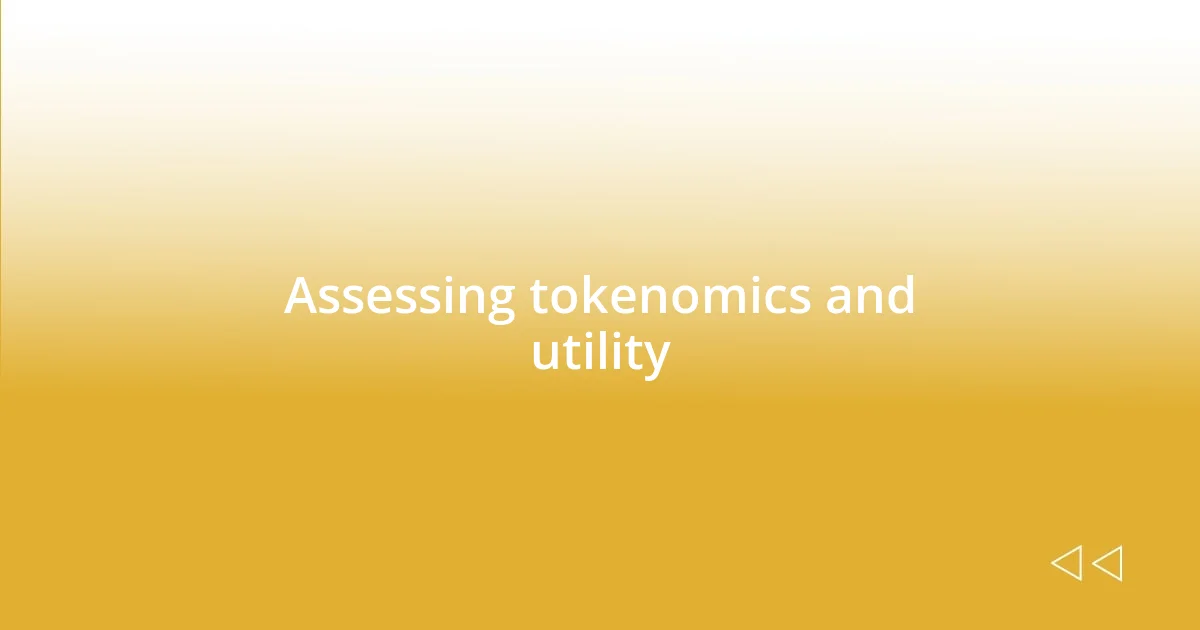
Assessing tokenomics and utility
Assessing tokenomics and utility is one of those areas where I really feel the gravity of my choices as an investor. When I evaluate a project’s tokenomics, I dive into the supply and distribution models. For instance, I remember coming across a project where a significant portion of tokens was reserved for the team, which raised an immediate red flag for me. It felt imbalanced, like they were holding all the cards, and it made me question how genuine their commitment to the community was. Have you ever noticed how a project’s token allocation can shape its long-term vision?
Utility is equally crucial; the token needs to have a clear purpose beyond mere speculation. I once invested in a project where the token was used for governance, allowing holders to vote on significant decisions. This not only empowered the community but also fostered a sense of ownership. I found myself more emotionally invested in the project’s success because I felt my voice was heard. Isn’t it incredible how utility can transform passive investors into active participants?
In my experience, analyzing these aspects often feels like peeling back the layers of an onion. Tokenomics isn’t just numbers on paper; it tells a story about how a project plans to sustain itself and engage its users. I recall a time when I spent hours poring over a project’s whitepaper, dissecting its mechanisms. By the end, I felt more equipped to make an informed decision, understanding not only the risks but also the potential rewards. When a project showcases strong tokenomics and utility, it genuinely excites me—like finding a gem in a field of stones.
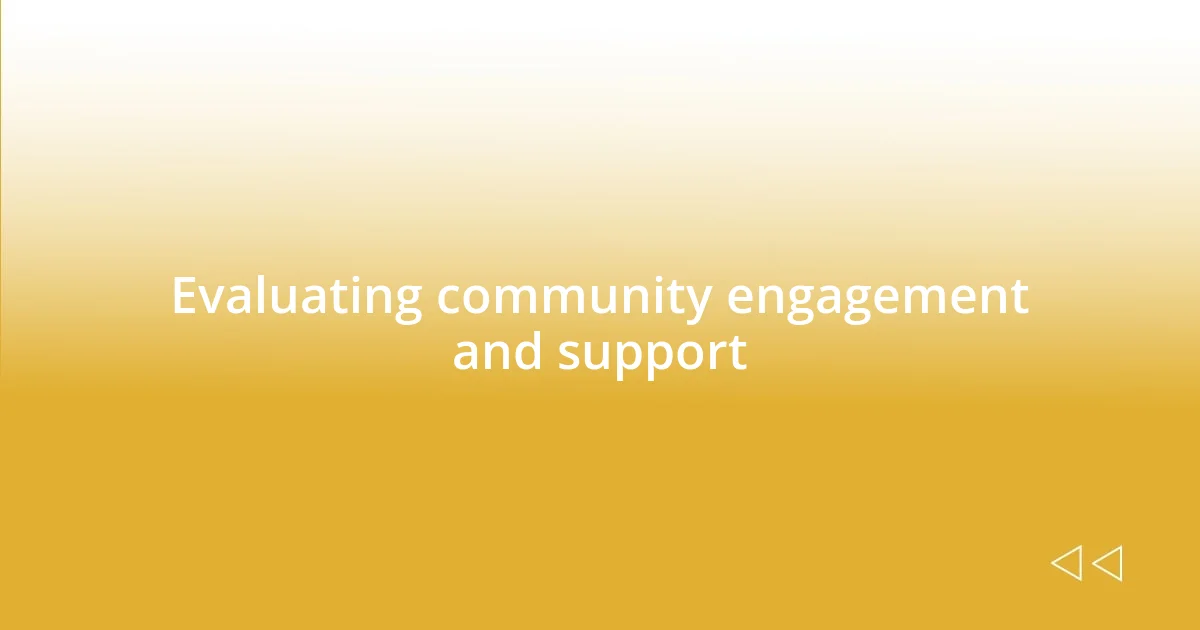
Evaluating community engagement and support
Engaging with a DeFi project’s community can provide invaluable insights into its health and prospects. I often check out online forums and social media channels where users express their thoughts and feelings. For instance, I vividly recall a project where the community was buzzing with excitement over upcoming features. The enthusiasm of the users gave me a sense of confidence—like I was part of something meaningful. Have you ever felt that electricity in a community, where you just know something special is unfolding?
It’s also interesting to notice how a project responds to feedback. I once observed a DeFi team that implemented suggestions from its community almost immediately. This level of responsiveness spoke volumes to me; it was as if they were saying, “We value your input.” I’ve learned that when teams don’t ignore their community, it often leads to stronger loyalty and trust. Have you reflected on how such interactions can either fortify or erode investor confidence?
Furthermore, I pay attention to grassroots support and initiatives within the community. There was a project I followed, where local meet-ups and online AMAs fostered an environment of genuine collaboration and friendship among users. Those moments made me feel connected, not just as an investor, but as a part of a family. It’s fascinating to consider how community spirit can elevate a project’s credibility and success—wouldn’t you agree that a tight-knit community can often serve as a project’s backbone?
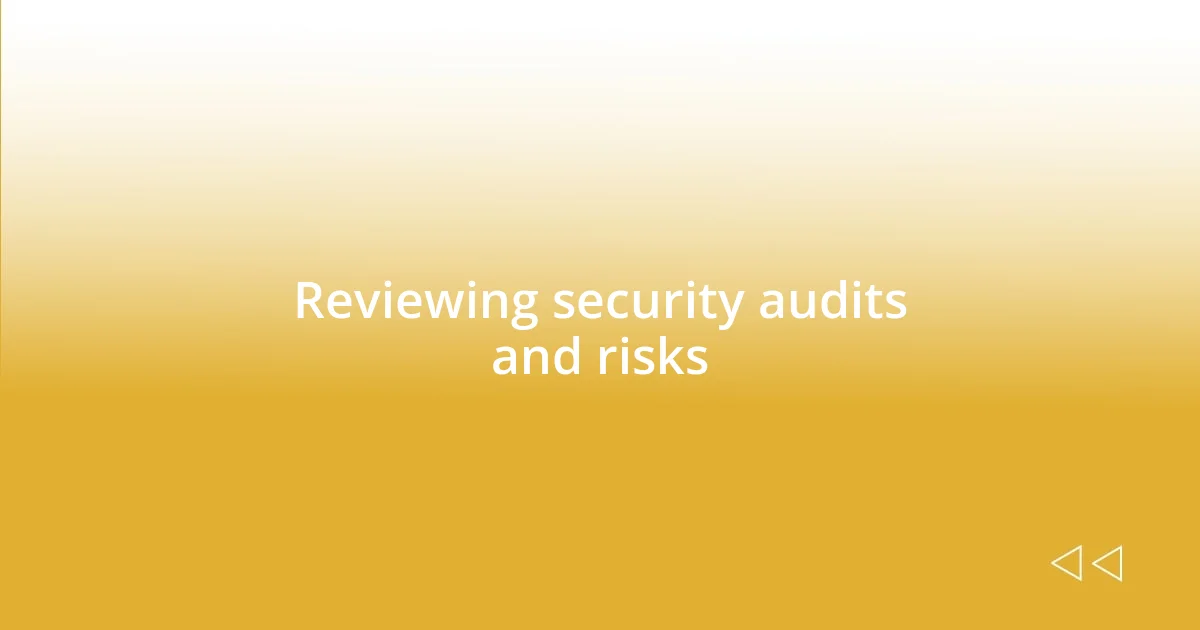
Reviewing security audits and risks
Security audits are a crucial aspect of any DeFi project that I take seriously. For me, a thorough audit acts as a safety net; it identifies vulnerabilities before they can be exploited. I remember looking into a project that had undergone multiple audits by reputable firms. This not only boosted my confidence but also made me feel reassured that the team prioritized security. Have you ever felt that sense of relief when you see a project backing its tech with a solid audit?
However, it’s essential to look beyond just the presence of audits. I once encountered a project that had an audit report, but it was old and barely touched on significant updates the project had made. This oversight raised my eyebrows. I thought about how dynamic the DeFi landscape is and realized that an outdated audit could be more misleading than helpful. What good does an audit do if it doesn’t reflect the current state of the project’s code?
I also closely examine the nature of the reported vulnerabilities and how they were addressed. I recall a project that had a minor security flaw which was disclosed publicly, but they took immediate and transparent action to rectify it. That kind of accountability earns my respect. It makes me wonder—doesn’t a project’s response to risk reflect its maturity and commitment to its users?
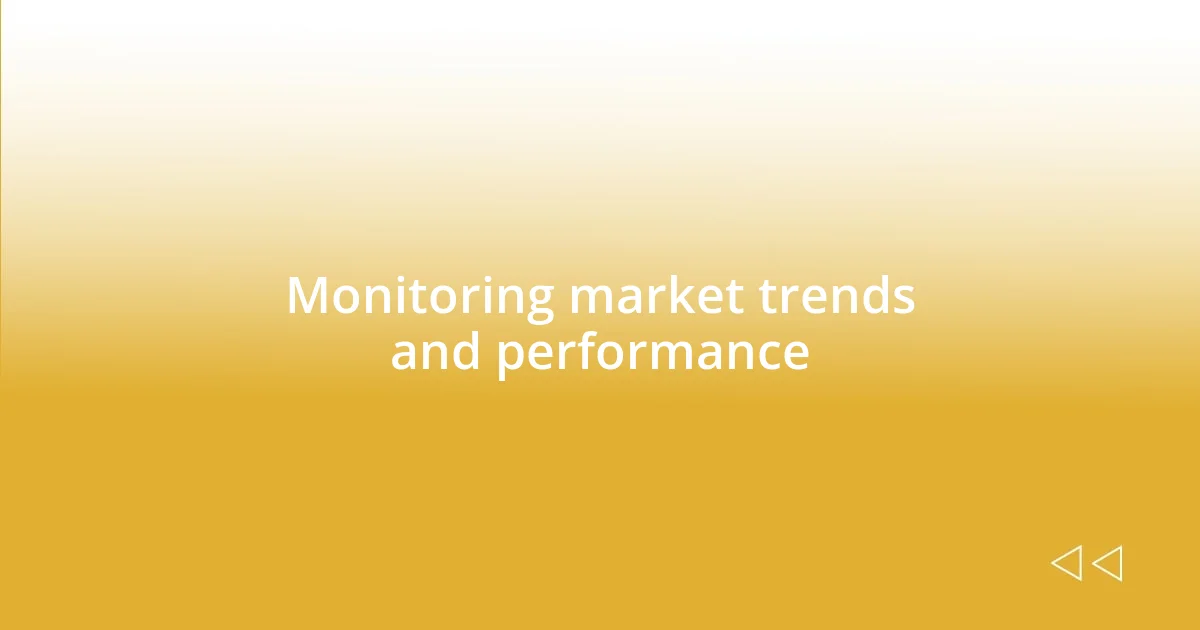
Monitoring market trends and performance
Monitoring market trends and performance is like having a finger on the pulse of the DeFi space. I often find value in analyzing charts and price movements, which can highlight patterns that might indicate a project’s trajectory. I remember one instance when I noticed a sudden spike in trading volume for a project I was following. Curiosity led me to dig deeper, and I discovered a partnership announcement that had the community buzzing. It’s intriguing how market activity can serve as a barometer for interest and potential.
Beyond just price, I consider overall market sentiment. During my journey, I’ve observed how external factors—like regulatory changes or technological advancements—can impact performance. For example, there was a period where Bitcoin’s fluctuations had a domino effect on various DeFi tokens. It made me realize that a project’s performance doesn’t exist in a vacuum; it’s essential to stay attuned to the bigger picture. How often have you noticed that a single event can shift market dynamics overnight?
Lastly, I also keep a close eye on the liquidity and trading volumes of projects I’m interested in. A few months ago, I followed a DeFi token that initially seemed promising but struggled with low liquidity. I felt uneasy as it became harder to buy or sell without affecting the price significantly. It dawned on me that liquidity acts like lifeblood for a project; without it, even the best ideas can falter. Have you ever felt the frustration of being unable to maneuver through a market that lacks depth? Understanding these performance indicators is crucial for navigating the unpredictable waters of DeFi.










